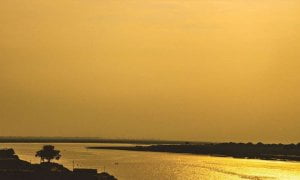Tourism is a vivacious sector in global economy. It generates occupations, both through direct and indirect employment in the tourism industrial front and in the sectors like transportation, arts and handicrafts respectively. It creates umpteen numbers of professionals with high skill proportion.
It provides opportunities to improve trade, economy, and balance of payment of any country. It gives a symbol of status to the country involved in promoting the tourism business. It is responsible for the multiplier effect which multiplies the money spent on the goods and services.
It generates more revenue to the small-scale business enterprises and rural communities. Moreover it is a generator of tax revenues through airport and hotel taxes. Such taxes are utilized in the development of schools, houses, and hospitals. Such is the status of tourism contributing to the overall benefit of a country.

1. International Tourism Exports – 2015.
It has witnessed faster growth when compared to all the international merchandise trade. Consecutively for the fourth year in 2015 tourism has gained importance beating all other trades. Tourism receipts around the world destinations have grown by 3.6% in 2015 while the arrival has grown by 4.4%.
Thereby the total export value of international tourism accounted to US$ 1.4 trillion. A total of 1,184 million tourists have visited international borders across the world. The various priorities on which the tourists had spent their valuable income are accommodation, food and drink, entertainment, shopping and other services and goods. Henceforth, US$ 1,232 billion (euro 1,110 billion) has been generated on these utilities.
2. Leading Outbound Tourism Markets.
In the year 2015 the leading outbound tourism markets are dominated by China, the United States and the United Kingdom. China is in the leading position as it has touched double-digit growth with respect to the expenditures made in the countries like Japan, Thailand, United States and various European destinations. It is found that all these countries have got benefitted out of the expenditures made by the Chinese travelers.
Their spending has increased by 25% reaching 292 billion while the outbound travelers increased to 10% accounting to 128 million of them. Next to China, United States has secured second place in outbound tourism market. The number of outbound tourists has increased to US$120 billion which has shown a 9% increase, while the tourist arrivals has increased to 3 million recording an increase of 8%.
United Kingdom has recorded an increase of 8% globally amounting to US$ 63 billion while the outbound tourists accounted to 65 million. Euro was found to be weaker during the year 2015 and therefore, the world’s largest market has witness a slight decline in the spending of its residents across the world.
It is accounted to be US$76 billion. The outbound tourism expenditure of France has recorded to be US$ 38 billion, Russia’s tourism expenditure to be US$ 35 billion and US$ 25 billion with respect to that of the Republic of Korea.
The non-resident international tourists have generated US$ 210 billion in exports. On an average the total value of the tourists spending by them is recorded to be US$ 4 billion per day.
According to World Trade Organization, out of the total world exports international tourism contributes to 7% while the service exports related to tourism represents to 30%. It has overtaken the merchandise trade to 2.8% in 2015.
Tourism industry is placed in the thirds position next only to fuels and chemical industry while the fourth and fifth positions are occupied by food and automotive industries respectively. It is ranked to be the first export sector in most of the developing countries.
In spite of the exchange rate fluctuations that prevailed throughout the year 2015 there had been very good tourist receipts witnessed in terms of US dollars in the Americas, Asia, Pacific and the Middle eastern countries, Europe and Africa. An increase of 4% has been witnessed by the Americas, Asia, Pacific and Middle East while 3% has been recorded in Europe and in Africa the same is witnessed to be 2%.
3. The Caribbean, Central and South America.
Compared to North America which witnessed an increase in receipts of 3%, the Caribbean, Central and South America recorded growth in receipts by 7%. It was certainly due to the account of the value of the US dollar. It has encouraged the outbound travel from United States benefitting all the nearby countries across the region.
The countries which depend solely on the raw-materials are pushed to reduce the oil prices to the exporting countries making a severe toll on the revenue generated from their indigenous fuel products. Therefore they are forced improve their revenue by concentrating more on the tourism sector.
Mr. Rifai, Secretary-General UNWTO quotes the same as “Tourism is increasingly an essential component of export diversification for many emerging economies as well as several advanced ones.”
The countries like The United States, China, Spain and France have showed continuous growth with US$ 178 billion, China US$ 114 billion, US$ 57 billion and US$ 46 billion respectively. These countries have consistently in the top destinations by the means of tourist receipts and tourist arrivals.
4. Asia Pacific Region.
The Asia Pacific region is the one which has been the fastest emergent region in tourism growth in the world. Outsized numbers of Asia Pacific countries are witnessing tourism as one of the important sector that contributes to the economic growth.
The factors such as political stability, economic growth, disposable income, leisure time, and belligerent tourism campaigns have been contributing to noteworthy escalation of tourism. Next to Europe the Asia Pacific region is the mostly visited in the world. In the year 2015 the region had received tourist inflow o 279 million. It is almost one-fourth of the world’s total tourist arrivals.
Highest growth is witnessed by South-East Asia which has increased by 8% and followed by it Oceania which has increased by 7%. Intraregional tourism within the Pacific Asia region recorded 225 million tourist arrivals which 80% of the total regional arrivals. Remaining 20% of the arrivals to the region are from the other regions.
The region had been experiencing benefits through tourism development in the social and economic front. Economically through the years 2005 to 2015 the GDP has found a reasonable increase of 87% from USD 3,190 in 2005 to USD 5,960 in 2015. The tourism receipt of this region is recorded to be USD 418 billion in 2015, which is 33% of the world’s total which has double since 2000 from 17%.
The GDP of the Asia Pacific region has increased due to the contribution of the countries within the region. The leading economies with respect to its growth witnessed due to the performance of 71% by North- East Asia, 45% by China and 17% by Japan. India contributed 9% of the regional GDP, Republic of Korea 6% and Australia 5%. The future of Asia Pacifica region is expected to experience remarkable growth in the coming years.
5. Europe.
European continent tops with respect to the tourist arrivals and tourist expenditure all over the world. It has made significant contribution to the economy of the European economy. Within the European region, Northern and Southern and Mediterranean Europe recorded high contribution compared to arrivals in Western, Central and Eastern Europe.
Spain has secured top place among all the member countries of Europe in tourist arrivals. It has recorded 270 million arrivals, followed by Italy with arrivals of 193 million, France having 130 million tourists and United Kingdom which had recorded 118 million arrivals.
These top four countries totally contributed to 56.2% of the total arrivals of all the European countries. With respect to the tourist receipts Spain has received EUR 50.9 billion, France EUR 41.4 billion, the United Kingdom 41.1 billion, Italy 5.6 billion and Germany 33.3 billion.
6. Contribution of Tourism to Indian economy.
It contributes 6.8% to our total GDP to and generates 8.7% of total GDP towards employment. It generates Foreign Exchange earnings of $2.1 billion.
• Tourism as an Employment generator.
Investments made on this sector generate huge economic growth in itself as well as the other sectors like Manufacturing and Agriculture. For example if an investment of Rs. 10 lakhs is invested in this sector it generates employment for 78 people in the tourism and hospitality industries.
Similarly if the same is invested on the Manufacturing and the Agricultural industry it generates 45 and 18 jobs respectively. (Source: Ministry of Tourism, Government of India). The following pictorial representation depicts it very clearly about the status of tourism compared to the other
sectors.
Therefore, it can be said that it is one of the most important prominent employment generator.
• Status of Indian Tourism at Global Level.
World Economic Forum’s Travel & It’s Competitiveness Index 2015 report has ranked India in the 52nd place. India has only 0.68% of the global FTAs which is less than 1%. It shows that in the global arena the performance of tourism is not up to the mark.
Even China and Malaysia are performing better compared to India securing a rank of 17 and 25 respectively. Inspite of 27 World Heritage sites, 10 Biosphere Reserves, 7500 km long coastline, 9000 years of cultural heritage still the status of Indian tourism in the world is lagging behind.
7. Countries Dependent on Tourism.
It plays significant role in the development of the host country. It is considered to be a big boon to the countries encouraging tourism. There are many countries which rely completely on tourism. These countries find their major revenue from this predominant industry.
United Nations World Tourism Organisation has put forward a list of top 10 countries which solely dependent on this industry. They are British Virgin Islands, Macau, Aruba, U.S. Virgin Islands, Turks and Caicos, Luxemburg, Bahamas, Bermuda and Anguilla.
It is estimated that British Virgin Islands in the Caribbean generates almost 45% of the total national income from tourism. Yacht chartering industry and cruise ships’ entertainments contributes the major part. Tourism receipt per capita is estimated as $17,621 and the average tourist spending is estimated as $1,285 with respect to British Virgin Islands.
Macau, the special administrative region of China is ranked 21st in the FTAs and 24th in terms of tourist receipts. More than 50% of the GDP of Macau is through Gaming and tourism and it accounts to 70% of the government’s revenue. A tourism receipt per capita is estimated at $16,797and the average tourist spending is estimated as $900 in Macau. Aruba, an island in the Southern Caribbean Sea, derives its major economy from tourism. It accounts to 41% of the total GDP of the island.
Aruba’s Tourism receipt per capita is estimated as $14,771 and an average tourist spending is estimated as $1,445. The United States Virgin Islands in the Caribbean thrives on the major economic activity – Tourism. It accounts to 80% of the total GDP of the island. Tourism receipt per capita is estimated as $12,466 and an average tourist spending is estimated as $2,495. Turks and Caicos are the British Overseas Territories known for its tourism based economy as 50% of the jobs in the Islands are created in this field.
Estimated Tourism receipts per capita is $12,420 and an average tourist spending estimated to be $1,885 in Turks and Caicos. Another British Overseas Territory, Cayman Islands of the Caribbean Sea profit excellently from tourism sector. It consists of a number of hotels and resorts. Almost 60% of the total national GDP is derived from tourism alone.
Tourism receipt per capita for Cayman Islands is estimated at $12,042 and $1,995 is the average tourist spending. The landlocked country, Luxembourg in Western Europe finds it as an important component in the contribution to the country’s economy. It is the “Green Heart of Europe”.
11.7% of the total working population is employed in the tourism sector in Luxembourg. Tourism receipt per capita of Luxembourg is found to be $7,909 and $4,170 is the average tourist spending.
One of the affluent countries in the Atlantic Ocean is the Bahamas. The attractions like underwater parks, marine life draws more tourists to the Bahamas. More than 60% of the GDP of Bahamas comes from the Tourism industry. New hotels, resorts and residents contribute to the solid growth in the GDP.
The tourist receipts per capita of Bahamas contribute to $6,288 and the average tourist spending is $1,205. The British Overseas Territory in the Atlantic Ocean, Bermuda witnesses 360,000 FTAs annually. Almost 28% of the GDP of Bermuda is generated through the tourism industry which cannot be ignored as a contribution.
The tourist receipt per capita of Bermuda is found to be $5,451 and the average tourist spending is estimated to be $1,305. Anguilla also a British overseas territory in the Caribbean is another country that relies on the tourism resources. Paucity of natural resources and land availability exerts pressure on the revenue obtained from the tourism industry.
Over 75% of the GDP of Anguilla is generated from Tourist expenditure. The tourist receipt per capita of Anguilla is found to be $5,319 and the average tourist spending is estimated to be $1,280. From the above data of tourist receipts and average tourist expenditure, it clearly exhibits that these countries rely mostly on it’s resources and without tourism these nations would not be able to sustain financially.
World Travel & Tourism Council (WTTC) has proposed that added to the island countries listed by UNWTO, the other places that are self-reliant on it are Maldives, Seychelles, Vanuatu, Former Netherlands Antilles, Antigua and Barbuda, Cape Verde, Belize, Malta, Palestinian territories, St Lucia, Fiji, Cambodia, Croatia, Mauritius, and US Virgin Islands.
8. Tourism in the Global Agenda.
At the global level it has gained importance as governments of the world countries recognized that tourism is a sector that contributes to the socio economic growth and employment generation. An Open Letter was received by thirteen countries of the world from UNWTO/WTTC recognizing the contribution of Tourism towards of the economic development and professional skilled laborers.
It had also stressed on promotion of sustainable tourism development. By the end of 2014 almost 70 Heads of States and Governments have received this Open Letter as a token of appreciation for the contribution towards the economic growth and employment multiplier. It shows that tourism has sustained prominence in the international arena.
9. Promoting Sustainable Tourism Development.
In November 2014 the UNWTO had created a Programme on Sustainable Tourism of the 10 Year Framework of Programmes (10YFP) on Sustainable Production and Consumption after recognition of the importance of tourism by it.
Observatories were made to assess the impact of tourism and enhance the global sustainable tourism. Accessible tourism gained importance after the San Marino Declaration made based on the First Conference conducted on Sustainable tourism on Accessible Tourism in Europe.
Almost 163 private companies from 22 countries had joined together to contribute to the importance of UNWTO Global Code of Ethics for Tourism.
10. Contribution to Poverty Reduction and Development.
It had been advancing as one of the sector eradicating poverty. Poverty alleviation has become the main motto of output of promotion of it. It not only helps in the sustainable tourism development but also uplift the poor people through ensuring huge employment opportunities.
It is viewed as a main source of foreign exchange to the developing as well as the least developed countries. UNWTO has made ground work by creating capacity-building throughout the world through provision of technical assistance to the community people so that they might improve their standard of living through prosperous tourism development.




